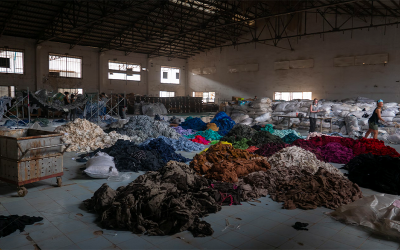Flaws in Fast Fashion: the Atacama Desert Dumping Ground
20 April 2022
Students from the Energy, Environment and Resources in Developing Countries module have written blogs on current energy, environment, and resources problems in one or more developing countries - here Esther Batt reviews the real price of fast fashion.

The term “fast fashion” refers to the mass-production of clothing, which is made at low cost and quality and at a rapid pace to meet consumer demands and trends [1]. Consumers prioritise price and turn a blind-eye to ethics and sustainability, rapidly increasing overconsumption and incentivising overproduction. But the industry has an even darker side, and the planet is facing the consequences.
The real price of fast fashion
The industry has detrimental impacts previously overlooked. Responsible for ~10% of global greenhouse gas emissions [2], the industry consumes more energy than aviation and shipping combined [3]. But the consequences don’t stop there. Damages to water systems, animal welfare and human rights abuses are vast.
One cotton t-shirt requires 2,700 litres of water, enough to keep you hydrated for three years [3,4]. Water and microplastic pollution is caused by synthetic materials and toxic chemicals: 2.5 billion gallons of textile waste contaminate around 70% of Asia’s waters [5]. Garment workers are forced to work extreme hours for measly wages, subject to dangerous conditions which put them at risk [6], not to mention the ~168 million underage workers [7].
What’s worse is that those in developing countries (the producers) are disproportionately affected to those in developed countries (the consumers). They hold production-related competitive advantage [8] – economic terms for being able to produce goods more cheaply or better or faster than competitors. Therefore, many fast fashion brands have shifted their production to developing countries, exploiting poor areas [9].
Out of sight, out of mind…

Most fast fashion clothing uses polyester, a fabric made from plastic fibres requiring plenty of oil, and so the garments will take at least 200 years to decompose [12]. Chileans are faced with an eyesore which will get out of control if no measures are taken. The unused clothes threaten biodiversity, the health and well-being of locals and release smoke pollution once incinerated.
The country has tried to take a stance by implementing the Law of Extended Responsibility of the Producer. This establishes a legal framework for waste management, while holding importers responsible for the waste they generate [13]. Unfortunately, limited resources mean controlling illegal resource dumps is near impossible [10].
Whilst arguably an awful situation, innovative solutions have created silver linings. For instance, the company EcoFibra helps create more sustainable end-uses for these materials. The picture above depicts men in factories using discarded clothes to make wooden isolation panels for social housing [11]. But this isn’t a long-term fix.
A future for fast fashion?

Are you interested in studying Sustainable Resources at UCL?

- Sustainable Resources: Economics Policy and Transitions MSc
- Economics and Policy of Energy and the Environment MSc
- Business and Sustainability MSc
References
- Bick R, Halsey E, Ekenga C. The global environmental injustice of fast fashion. Environmental Health. 2018;17(1).
- United Nations Climate Change. UN helps fashion industry shift to low carbon. Learn more: https://unfccc.int/climate-action/climate-neutral-now
- Barroca G. Fast Fashion: what we are not seeing [Internet]. Awareness News. 2022 [cited 22 February 2022]. Available from: https://theawarenessnews.com/2021/03/25/fast-fashion-what-we-are- not-seeing/
- National Geographic. How Your T-Shirt Can Make a Difference. Youtube; 2013. Available from: https://www.youtube.com/watch?v=xEExMcjSkwA
- Noyes L. Fast Fashion 101: Everything You Need to Know [Internet]. EcoWatch. 2021 [cited 22 February 2022]. Available from: https://www.ecowatch.com/fast-fashion-guide-2655084121.html
- Brooks A. Clothing Poverty: The Hidden World of Fast Fashion and Second-Hand Clothes. 2nd ed. London: Bloomsbury Publishing; 2019.
- International Labour Office and United Nations Children’s Fund, Child Labour: Global estimates 2020, trends and the road forward, ILO and UNICEF, New York, 2021.
- Niinimäki K, Peters G, Dahlbo H, Perry P, Rissanen T, Gwilt A. The environmental price of fast fashion. Nature Reviews Earth & Environment [Internet]. 2020;1(4):189-200. Available from: https://www.nature.com/articles/s43017-020-0039-9.pdf
- Ganz G. How Fast Fashion Causes Environmental Poverty. Borgen Magazine [Internet]. 2020 [cited 22 February 2022];. Available from: https://www.borgenmagazine.com/fast-fashion-causes- environmental-poverty/
- BBC. The fast fashion graveyard in Chile's Atacama Desert. BBC News; 2022. https://www.bbc.co.uk/news/av/world-60249712
- Glover E. Chile's Atacama Desert becomes dumping ground for fast fashion leftovers. The Independent [Internet]. 2021 [cited 22 February 2022;.
- Abelvik-Lawson H. 9 reasons to quit fast fashion [Internet]. Greenpeace. 2019 [cited 23 February 2022]. Available from: https://www.greenpeace.org.uk/news/9-reasons-to-quit-fast-fashion-this-b... Friday/
- Law Nº 20.920, Extended Producer Responsibility [Internet]. Brokering Abogados. 2020 [cited 23 February 2022]. Available from: https://www.brokering.cl/law-no-20-920-extended-producer- responsibility/
Photo by Bailey Hall on Unsplash
Photo by Francois Le Nguyen on Unsplash
Photo by Hello I'm Nik on Unsplash
 Close
Close

